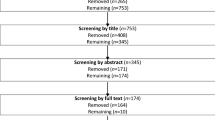Abstract
This article emphasizes the need for short-term intervention programs in emergency shelters for children. Focus is placed on the need to work with children's fears and anger in unplanned placement. An overview of a short-term group program is presented and discussed. Recommendations are offered for the continued development of such programs, and their value for child care workers is suggested as well.
Similar content being viewed by others
References
Adler, D., Drake, R., & Storm, R. (1984). Viewing chronic mental illness.Comprehensive Psychiatry, 25(2), 192–207.
Block, N. (1981). Towards reducing recidivism in foster care.Child Welfare, 60, 597–609.
Brody, V., Fenderson, C., & Stephenson, S. (1976).Sourcebook for finding your way to helping young children through developmental play. Pupil Personnel Services Demonstrated Project, Florida State Department of Education.
Compher, J. V. (1983). Home services to families to prevent child placement.Social Work, 28(5), 360–364.
Dennison, S.T., & Glassman, C.K. (1987).Activities for children in therapy: A guide for planning and facilitating therapy with troubled children. Springfield, IL: Charles C. Thomas.
George, C., & Main, M. (1979). Social interactions of young abused children: Approach, avoidance, and aggression.Child Development, 50(2), 306–318.
Green, A.H. (1981). Core affective disturbance in abused children.Journal of the American Academy of Pediatrics, 9(3), 453–456.
Hawkins, R. P., Meadowcroft, P., Trout, B. A., & Luster, W. C. (1985). Foster family-based treatment. Special Issue: Mental Health Services to Children.Journal of Clinical Child Psychology, Fall14(3), 220–228.
Hoffman-Plotkin, D., & Twentyman, C. (1985). A multimodal assessment of behavioral and cognitive deficits in abused and neglected preschoolers.Child Development, 55(3), 794–802.
Kazdin, A.E., Moser, J., Colbus, D., & Bell, R. (1985). Depressive symptoms among physically abused and psychiatrically disturbed children.Journal of Abnormal Psychology, 94(3), 298–307.
Kinard, E.M. (1980). Mental health needs of abused children.Child Welfare, 59(8), 451–62.
Kingsley, R., & Cook-Hatala, C. (1988). A survey of child care workers: Implications for administrators regarding job stress and satisfaction.Child and Youth Care Quarterly, 17(4), 281–287.
Maier, H. (1987). Child care within an organizational context: The inherent strain.Child and Youth Services, 9(2), 151–185.
Martin, H. P., & Beezley, P. (1976). Personality of abused children. In H. P. Martin (Ed.),The Abused Child. Cambridge, MA: Ballinger Publisher.
Segal, V., & Schwartz, S. (1987). Admission-discharge patterns of children in emergency treatment shelters: Implications for child and youth care practitioners.Child and Youth Care Quarterly, 16(4), 263–271.
Wolfe, D.A., & Mosk, M.D. (1983). Behavioral comparisons of children from abusive and distressed families.Journal of Consulting and Clinical Psychology, 51(5), 702–8.
Author information
Authors and Affiliations
Rights and permissions
About this article
Cite this article
Hurn, J.J., Dupper, D., Edwards, K. et al. Treatment intervention in child abuse emergency shelters: The crucial needs. Child Youth Care Forum 20, 133–140 (1991). https://doi.org/10.1007/BF00756694
Issue Date:
DOI: https://doi.org/10.1007/BF00756694




